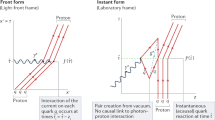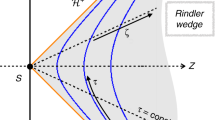Abstract
The unification of relativity and thermodynamics has been a subject of considerable debate over the past 100 years. The reasons for this are twofold. First, thermodynamic variables are non-local quantities and therefore single out a preferred class of hyperplanes in spacetime. Second, there exist different ways of defining heat and work in relativistic systems and all of them seem equally plausible. These ambiguities have led, for example, to various proposals for the Lorentz-transformation law of temperature. However, traditional ‘isochronous’ formulations of relativistic thermodynamics are neither theoretically satisfactory nor experimentally feasible. Here, we demonstrate how these deficiencies can be resolved by defining thermodynamic quantities with respect to the backward-lightcone of an observation event. This approach yields new predictions that are, in principle, testable and allows for a straightforward extension of thermodynamics to general relativity. Our theoretical considerations are illustrated through three-dimensional relativistic many-body simulations.
This is a preview of subscription content, access via your institution
Access options
Subscribe to this journal
Receive 12 print issues and online access
$209.00 per year
only $17.42 per issue
Buy this article
- Purchase on Springer Link
- Instant access to full article PDF
Prices may be subject to local taxes which are calculated during checkout




Similar content being viewed by others
References
Callen, H. B. Thermodynamics as a science of symmetry. Found. Phys. 4, 423–442 (1974).
Callen, H. B. Thermodynamics and an Introduction to Thermostatistics 2nd edn (Wiley, 1985).
Landau, L. D. & Lifshitz, E. M. Statistical Physics 3rd edn (Course of Theoretical Physics, Vol. 5, Butterworth-Heinemann, 2003).
Öttinger, H. C. Beyond Equilibrium Thermodynamics (Wiley–IEEE, 2005).
Lloyd, S. Quantum thermodynamics: Excuse our ignorance. Nature Phys. 2, 727–728 (2006).
Bekenstein, J. D. Black holes and entropy. Phys. Rev. D 7, 2333–2346 (1973).
Planck, M. Zur Dynamik bewegter Systeme. Ann. Phys. (Leipz.) 26, 1–34 (1908).
Einstein, A. Über das Relativitätsprinzip und die aus demselben gezogenen Folgerungen. J. Radioaktivität Elektronik 4, 411–462 (1907).
Van Kampen, N. G. Relativistic thermodynamics of moving systems. Phys. Rev. 173, 295–301 (1968).
Ott, H. Lorentz-Transformation der Wärme und der Temperatur. Z. Phys. 175, 70–104 (1963).
Landsberg, P. T. Does a moving body appear cool? Nature 212, 571–572 (1966).
Landsberg, P. T. Does a moving body appear cool? Nature 214, 903–904 (1967).
Ter Haar, D. & Wergeland, H. Thermodynamics and statistical mechanics on the special theory of relativity. Phys. Rep. 1, 31–54 (1971).
Komar, A. Relativistic temperature. Gen. Rel. Grav. 27, 1185–1206 (1995).
Dunkel, J. & Hänggi, P. Relativistic Brownian motion. Phys. Rep. 471, 1–73 (2009).
Yuen, C. K. Lorentz transformation of thermodynamic quantities. Am. J. Phys. 38, 246–252 (1970).
Pryce, M. H. L. The mass-centre in the restricted theory of relativity and its connexion with the quantum theory of elementary particles. Proc. R. Soc. Lond. 195, 62–81 (1948).
Gamba, A. Physical quantities in different reference systems according to relativity. Am. J. Phys. 35, 83–89 (1967).
Amelino-Camelia, G. Relativity: Still special. Nature 450, 801–803 (2007).
Jüttner, F. Das Maxwellsche Gesetz der Geschwindigkeitsverteilung in der Relativtheorie. Ann. Phys. (Leipz.) 34, 856–882 (1911).
Cubero, D., Casado-Pascual, J., Dunkel, J., Talkner, P. & Hänggi, P. Thermal equilibrium and statistical thermometers in special relativity. Phys. Rev. Lett. 99, 170601 (2007).
Abramowitz, M. & Stegun, I. A. (eds) Handbook of Mathematical Functions (Dover, 1972).
Van Kampen, N. G. Lorentz-invariance of the distribution in phase space. Physica 43, 244–262 (1969).
Debbasch, F. Equilibrium distribution function of a relativistic dilute perfect gas. Physica A 387, 2443–2454 (2007).
Cercignani, C. & Kremer, G. M. The Relativistic Boltzmann Equation: Theory and Applications (Progress in Mathematical Physics, Vol. 22, Birkhäuser, 2002).
Campisi, M. Thermodynamics with generalized ensembles: The class of dual orthodes. Physica A 385, 501–517 (2007).
Liu, C. Einstein and relativistic thermodynamics. Br. J. Hist. Sci. 25, 185–206 (1992).
Liu, C. Is there a relativistic thermodynamics? A case study in the meaning of special relativity. Stud. Hist. Phil. Sci. 25, 983–1004 (1994).
Van Kampen, N. G. Relativistic thermodynamics. J. Phys. Soc. Jpn 26 (Suppl.), 316–321 (1969).
Arzelies, H. Transformation relativiste de la temperature et de quelques autres grandeurs thermodynamiques. Nuovo Cimento. 35, 792–804 (1965).
Arzelies, H. Sur le concept de temperature en thermodynamique relativiste et en thermodynamique statistique. Nuovo Cimento. B 40, 333–344 (1965).
Eddington, A. S. The Mathematical Theory of Relativity (Univ. Press Cambridge, 1923).
Misner, C. W., Thorne, K. S. & Wheeler, J. A. Gravitation 23rd edn (W. H. Freeman, 2000).
Weinberg, S. Gravitation and Cosmology (Wiley, 1972).
Bennett, C. L. Cosmology from start to finish. Nature 440, 1126–1131 (2006).
Marra, V., Kolb, E. W. & Matarrese, S. Lightcone-averages in a Swiss-cheese universe. Phys. Rev. D 77, 023003 (2008).
Wheeler, J. A. & Feynman, R. P. Classical electrodynamics in terms of direct interparticle action. Rev. Mod. Phys. 21, 425–433 (1949).
Currie, D. G., Jordan, T. F. & Sudarshan, E. C. G. Relativistic invariance and Hamiltonian theories of interacting particles. Rev. Mod. Phys. 35, 350–375 (1963).
Montakhab, A., Ghodrat, M. & Barati, M. Statistical thermodynamics of a two dimensional relativistic gas. Phys. Rev. E 79, 031124 (2009).
Berges, J. Introduction of nonequilibrium quantum field theory. AIP Conf. Proc. 739, 3–62 (2004).
Hakim, R. Remarks on relativistic statistical mechanics I. J. Math. Phys. 8, 1315–1344 (1965).
Sexl, R. U. & Urbantke, H. K. Relativity, Groups, Particles (Springer, 2001).
Author information
Authors and Affiliations
Contributions
J.D. carried out the analytical calculations and S.H. conducted the numerical simulations. All three authors contributed extensively to discussions of the content and to writing the paper.
Corresponding author
Rights and permissions
About this article
Cite this article
Dunkel, J., Hänggi, P. & Hilbert, S. Non-local observables and lightcone-averaging in relativistic thermodynamics. Nature Phys 5, 741–747 (2009). https://doi.org/10.1038/nphys1395
Received:
Accepted:
Published:
Issue Date:
DOI: https://doi.org/10.1038/nphys1395
This article is cited by
-
What is the temperature of a moving body?
Scientific Reports (2017)
-
Consistent thermostatistics forbids negative absolute temperatures
Nature Physics (2014)
-
Transition in the Equilibrium Distribution Function of Relativistic Particles
Scientific Reports (2012)
-
Always look back
Nature Physics (2009)



